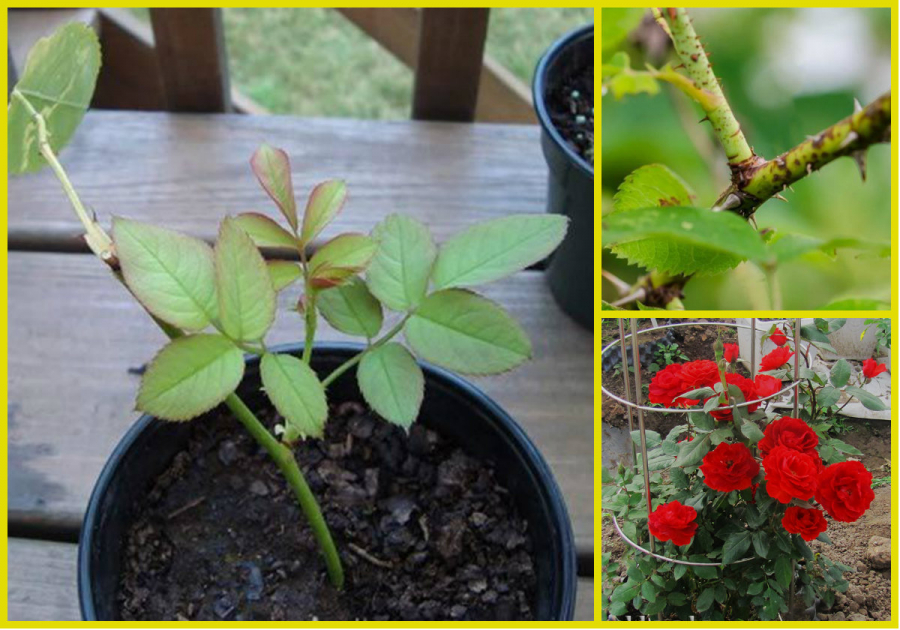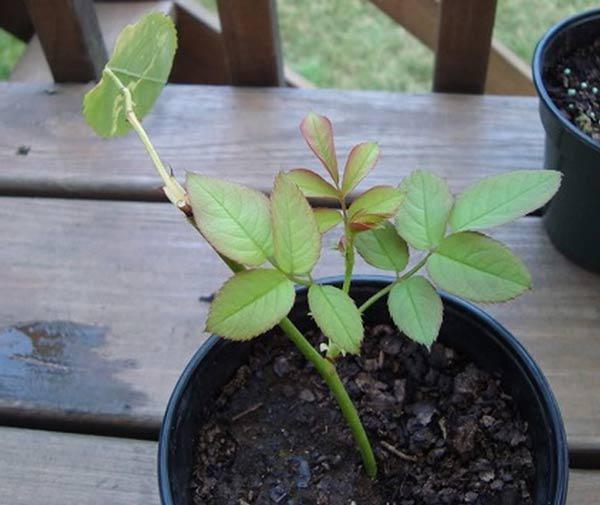1. How to Propagate Roses from Cuttings
Timing

Propagating roses from cuttings is essentially a form of stem cutting, and it can be done almost any time of the year. However, the best time to do so is considered to be from February to April and from August to October.

Propagating during the rainy season is advantageous as it reduces the need for frequent watering. On the other hand, propagating in the dry season requires close monitoring and regular watering to keep the soil moist, which is crucial for the new cuttings to take root and thrive. Additionally, when propagating in the dry season, it is essential to provide shade or construct an overhead canopy.
Soil for Stem Cuttings
For rose stem cuttings, it is recommended to use a mixture of well-composted manure, such as cow dung or worm castings, with burnt rice husk soil.
Before planting, loosen the soil by turning it over and watering it to ensure adequate moisture. When planting the cuttings, insert them about 2 cm deep into the soil, keeping them upright and straight, without any tilting.
Selecting Rose Varieties for Stem Cuttings
To maximize the success rate, choose hardy rose varieties such as wild roses or forest roses, even though their flowers may not be as aesthetically pleasing. Other rose types with lower vitality can also be propagated, but it is important to note that some roses are not suitable for stem cuttings due to their low starch content, which makes it challenging for them to develop new roots.
Techniques for Choosing Stem Cuttings
Selecting the right stem cuttings is a critical step in the process of propagating roses. It is best to choose sections from the middle part of the stem, either from the base or the tip, and opt for stems that are in the flowering stage. The chosen stems should be semi-hardwood, neither too old nor too young.
Ideally, select straight, healthy stems that have grown within the past year.
Stem Cutting Techniques
Once you have selected a healthy stem, about 20 cm in length, use a sharp knife or scissors to cut it at a 45-degree angle, ensuring a clean cut that doesn’t crush the stem. Remove any faded buds, leaves, and thorns from the lower part of the cutting, while the upper part can be pruned or left as is.
Immediately after cutting, soak the stem in a rooting hormone solution and plant it right away to prevent bacterial infection.
Detailed Guide to Propagating Roses from Cuttings
As mentioned earlier, propagating roses from cuttings involves taking a section of the parent plant’s stem and planting it in the soil. Over time, with proper care, this stem will develop new roots and grow into a new plant.
To begin the process, dig a small hole in the potting mix, loosen the soil, and water it to ensure adequate moisture. Insert the rose cutting about 1.5-2 cm deep into the soil, keeping it upright and straight. Then, gently pack the soil around the cutting and firm the base to ensure stability.
Fertilizer
Caring for the rose cuttings after planting is relatively straightforward. The key is to provide sufficient water without overdoing it, as waterlogging can be detrimental to the cuttings.
Once the cuttings start sprouting leaves, you can apply growth stimulants like IAA or NAA, or more common substances like Antonik, N3M, or Super Roo, to promote vigorous growth and larger blooms.
2. Rose Care
Location: Roses thrive in well-ventilated areas with ample sunlight. When exposed to at least eight hours of sunlight daily, roses grow robustly, exhibit vibrant colors, and are less susceptible to pests and diseases.

Watering: For garden-grown roses, water them once a day, preferably in the early morning or late afternoon. For potted roses, water them twice a day, once in the morning and once in the evening. Roses require sufficient water for photosynthesis, and inadequate watering can lead to red spider mite infestations, leaf yellowing, and leaf drop. Avoid watering in the evening, as water left on the leaves can promote fungal diseases.
Nutrition:
Nutrition plays a crucial role in determining whether your roses will bloom abundantly and produce large, vibrant flowers, especially when grown in pots. Observe the new branches; if they have a deep purple tint and are robust, your roses are receiving adequate nutrition. However, if the branches are thin and tall, additional nutrients are necessary.
Soil: Replace the soil annually.
Fertilizer: Alternate between foliar and root fertilization once a month.
When new shoots appear, apply Dynamic granular fertilizer around the base of the plant and water it in to promote nutrient absorption. Additionally, you can spray the leaves, stems, and roots with a solution of NPK or DAP agricultural fertilizer.
As the buds start to form, apply potassium fertilizer to enhance the color intensity of the roses. However, refrain from fertilizing once the flowers appear to avoid damaging them.
According to Khoevadep
The Secret to Vibrant Roses: Unveiling the 2 Essential ‘Miracle Workers’ You Need to Know About
Are you eager to transform your rose garden into a vibrant and blooming oasis? Discover the two “secret ingredients” that roses absolutely adore. One is tailored to promote vigorous growth, while the other works its magic to encourage larger, more beautiful blooms that last longer. Uncover the key to a stunning rose garden that will be the envy of your neighborhood.














